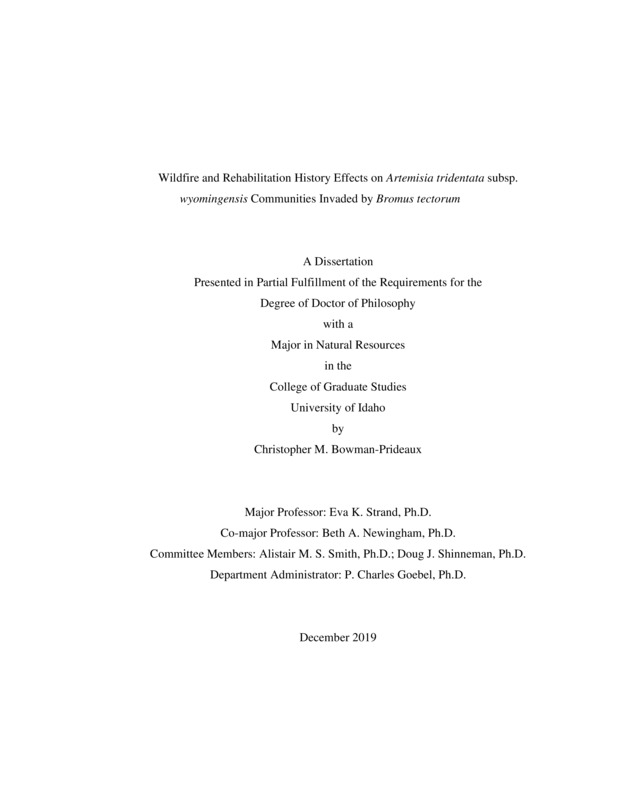Wildfire and Rehabilitation History Effects on Artemisia tridentata subsp. wyomingensis Communities Invaded by Bromus tectorum
Bowman-Prideaux, Chris. (2019-12). Wildfire and Rehabilitation History Effects on Artemisia tridentata subsp. wyomingensis Communities Invaded by Bromus tectorum. Theses and Dissertations Collection, University of Idaho Library Digital Collections. https://www.lib.uidaho.edu/digital/etd/items/bowmanprideaux_idaho_0089e_11726.html
- Title:
- Wildfire and Rehabilitation History Effects on Artemisia tridentata subsp. wyomingensis Communities Invaded by Bromus tectorum
- Author:
- Bowman-Prideaux, Chris
- Date:
- 2019-12
- Keywords:
- cheatgrass Fire history Fire regime Native perennial bunchgrasses Post-fire rehabilitation history
- Program:
- Natural Resources
- Subject Category:
- Natural resource management; Range management
- Abstract:
-
Currently, ~50% of the sagebrush steppe in the Great Basin, USA, has been lost to land-use change, plant invasions, and fire. These threats warrant potential rehabilitation treatments in order to maintain native plant communities; however, little research exists on the effects of rehabilitation treatment and fire history on native communities or sites with a history of rehabilitation across landscapes. To fill this gap we used a combination of fieldwork and spatial analysis to examine the effect of fire history, rehabilitation history, and environmental variables on plant community assembly, Bromus tectorum invasion, and changes in fire regime characteristics. Environmental variables explained 41% of the variation in plant communities while fire and rehabilitation history explained 44% of the variation in plant cover. Native species richness increased with elevation, but nonnative species richness did not. Bromus tectorum cover and density were inhibited by diverse native bunchgrass communities. Bromus tectorum decreased as the number rehabilitation treatments or time since treatment increased which was attributed to native bunchgrass establishment success and population growth, respectively. Fire regimes were in part determined by site moisture with more xeric sites burning more overall and more frequently at shorter intervals in the last twenty years. The type of vegetation treatment prior to the most recent fire played a role in fire regimes with sites that were aerially seeded prior to a fire having shorter fire turn intervals and more frequent fires in the last twenty years. The number of fires increased as sites became drier for aerially seeded sites, but not those with drill seeding. When the most recent treatment was drill seeding, it could increase the fire return interval and decrease frequency even when sites had a history of aerial seeding. This suggests increasing the number of drill seeding treatments can be used to establish diverse native plant communities that are resistant to Bromus tectorum and resilient to fire. Drill seeding can also reduce the numbers and frequency of fires and increase fire return intervals which may assist in Artemisia tridentata recruitment.
- Description:
- doctoral, Ph.D., Natural Resources -- University of Idaho - College of Graduate Studies, 2019-12
- Major Professor:
- Strand, Eva K.; Newingham, Beth A.
- Committee:
- Smith, Alistair M.S.; Shinneman, Doug J.
- Defense Date:
- 2019-12
- Identifier:
- BowmanPrideaux_idaho_0089E_11726
- Type:
- Text
- Format Original:
- Format:
- application/pdf
- Rights:
- In Copyright - Educational Use Permitted. For more information, please contact University of Idaho Library Special Collections and Archives Department at libspec@uidaho.edu.
- Standardized Rights:
- http://rightsstatements.org/vocab/InC-EDU/1.0/

